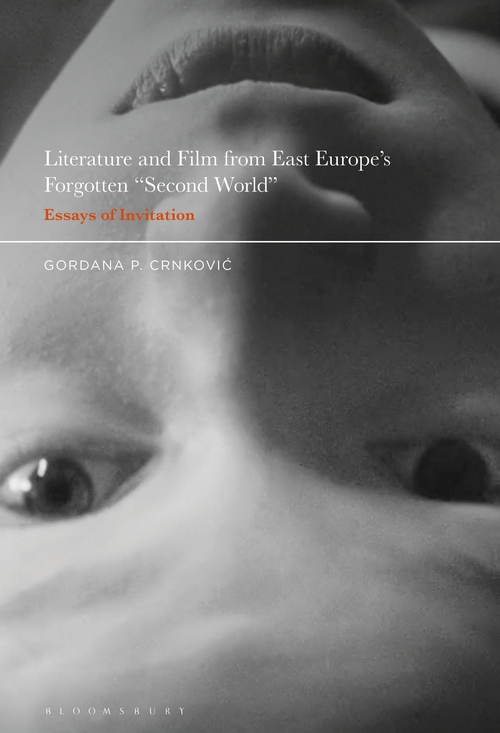
Literature and Film from East Europe’s Forgotten “Second World” Essays of Invitation by Gordana P. Crnković

Gordana P. Crnković’s Literature and Film from East Europe’s Forgotten “Second World:” Essays of Invitation offers an enlightening path, filled with new possibilities, experiences, and discoveries. In the book, Crnković, a Professor of Slavic and of Comparative Literature at the University of Washington, sets out to articulate the hidden beauty of Eastern Europe’s literature and film, while simultaneously resisting a one-note contextual analysis that fails to acknowledge the multitude of subjects, interests, concerns, and styles that come from this part of the world. She intends to open up the topics and discussions of her classroom to reach a wider audience. In quoting writers and poets such as Danilo Kiš, Vladimir Nabokov, and Milan Kundera, who each argue that work can be imprisoned by the all-too-common analysis that reduces it to its social, historical, or political context, Crnković paints a portrait of criticism that is free from pre-conceived ideas of texts. Seamlessly alternating between chapters on film and literature, she paves the way for new engagements that are especially attuned to one’s own unique experience of a literary or cinematic work.
Crnković’s book begins with a collection of short essays on texts and films produced between 1940 and 1992, and focuses on their various facets. For example, in her essay on Ivo Andrić’s The Bridge on the Drina, she paints a portrait of the myriad of special moments in the tale, from the calm narrative voice, to the tragedy that encompasses and awaits the character Fata. Central in Crnković’s work is her devout appreciation for a text or film’s formal elements. Through her analysis, she reminds the reader that these formal characteristics have the power to transmit tales of both imaginary and real worlds, and to create new worlds out of old ones. Her visual literacy is sharp, illustrating her attunement to aesthetics, the camera’s intentionality, as well as the ways in which the apparatus expands, draws attention to, or pulls viewers away in order to elicit certain affective responses or tell a meaningful visual tale.
Even though each of the selected films and texts are afforded their own focused chapter and many of them vary greatly in theme, form, and plot, they all are intricately bound by the ways in which they illustrate the liberating potentials of cinema and literature. For Cnrković, these forms of storytelling are multiplicitous, and possess an endless stream of possibility, oftentimes through their experimentations with space, temporality, form, and narrative structure, which contain a transformative function. Be it the ways Krzysztof Kieślowski’s Decalogue presents viewers with meditations on death or the performative nature and curiosity of a young woman’s gestures in Miloš Forman’s Loves of a Blonde, Crnković does not teach readers how to look, but rather, the possibility of looking at things differently. These works are not merely presented as forms of escape for moviegoers living in times of political turmoil. Rather, Crnković advocates for looking inward. In doing so, one may discover the radical potential for film and literature to enlighten audiences, through their explorations of the magic, madness, and tenderness of the human condition. In this way, Crnković’s book highlights the power in being a reader, or a viewer of great works of art, which can transform readers in the truest sense of the word, by encouraging people to perceive not only others, but themselves, in a new light. However, this can only be achieved if individuals allow themselves to engage with a work organically, deconditioned from dominant forms of engagement. As a result, although they may be touched or wounded, they have allowed themselves to be guided by the natural propensity to be felt or understood by something far beyond themselves. Ultimately, this universal draw to storytelling feels integral to Crnković’s appreciation of both cinema and literature.
In the second half of the book―“Probing Deeper”― the author’s scope widens to include longer essays centered around work that was either made in Eastern Europe during the socialist era ( the “Second World”) or drew heavily from it. She discusses different themes, motifs, and topics to contrast and compare films across a director’s career, providing us with clear-cut interpretations of the films’ encoded meanings, messages, or metaphors. From the thread that connects Polanski’s close-ups that frame the beginnings and ends of many films throughout his oeuvre, to the prevalence of Baudrillard’s notion of “semioticization” in Milcho Machevski’s 2010 film, Mothers, Crnković introduces readers to cinematic works through succinct summary, while simultaneously foregrounding theory and philosophy in her concentrated analysis of the moving images.
The final section, devoted to the writer’s perspective on criticism, is particularly telling, as it encapsulates the motivations behind Crnković’s own approach to the texts which she examines throughout the book. Among many writers, she cites Danilo Kiš, who criticizes the oftentimes reductive sociological approach to literary criticism, which reduces texts to architectural or social determinism, in effect freezing it in a particular time and space in accordance with the socio-political climate of the time in which it was written. Others, such as Marina Tsvetaeva, argue that critics should fine-tune their senses in order to live in the world of the poem, book, or film. If critics approach a work resisting new sensations, insights, and thoughts, they will close the door to the potential intensity of devout engagement, devoid of pre-conceived judgement. By focusing on her own intimate, unique reaction to different texts or films—articulating what certain subjects, stories, or mediums have taught her, or made her feel—Crnković invites her readers to do the same. Within academic scholarship, analysis is often fixated on the historical, political, and social contexts of literary or cinematic works. Preaching about art’s radical potential to provide a glimpse into another place or time, this hyper-focus on historical contextualization and accuracy suggests that the literary or artistic value of a film or novel derives from its didactic function to teach readers about a specific place or time in history. Albeit an insightful method of analysis at times, the notion of deriving meaning solely from what is outside of the work (its historical, social, political, or geographic context) is merely one way of discovering meaning. Crnković book instructs her readers that this approach may ultimately ignore the literary and filmic merits of the individual works themselves.
Literature and Film from East Europe’s Forgotten “Second World:” Essays of Invitation, feels grounded in a simple premise, rooted on the topic of why humanity loves film and literature so much to begin with. Perhaps simply loving something and desiring to share it with others is justification enough to want to learn about it, and write about it. The effect of this book is more affective than it is didactic. But the limitations of such arguments are clear from the beginning. Rather than providing an in-depth analysis of a particular period or movement in European literature and film, Crnković introduces readers to works they may have never encountered, or about which they otherwise may have never given a second thought. She gives her readers a nudge, and the rest is up to them. These “essays of invitation” open the portal to an invigorating world of lesser-known, or lesser-appreciated, titles, equally fascinating to both scholars in the field, as well as those who have yet to engage with Eastern European film and literature.
Natalia Orasanin is a graduate student and writer at York University’s Cinema and Media Studies program. Her research interests include eco-poetics, experimental filmmaking practices, and Eastern European cinema.
Literature and Film from East Europe’s Forgotten “Second World:” Essays of Invitation
By Gordana P. Crnković
Publisher: Bloomsbury Academic
Hardcover / 232 / 2021
ISBN: 9781501370656




